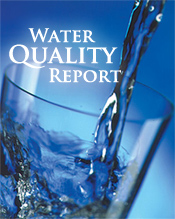
Frequently Asked Questions
Why does my water look milky?
The milky appearance is actually air bubbles, which are harmless. There are occasions when additional air is introduced into the water lines when making repairs. Also, in the winter when the outside temperature drops the water lines get cold and so does the water inside the line. When that cold water is brought inside your warm house, oxygen in the water is released into the water as tiny air bubbles. The air bubbles should disappear quickly; but should you continue to have problems give us a call. Your lines may need to be flushed.
Will a meter over register?
No. A meter will not over register, it will just quit registering. Meters come from the factory already tested.
What is a boil water advisory?
A boil water advisory is generally issued when water pressure drops below a certain point. Repairs to pipes may cause pressure to drop. A boil water advisory means that all water that is used for drinking or cooking should be brought to a rolling boil, and boiling should be continued for at least 3 minutes. Water that is not used for drinking or cooking does not need to be boiled. Ice-makers should be turned off. Bottled water or mouthwash should be used to brush teeth. Bottled or boiled water should be used for baby formula.
In the event of a main break, a boil water advisory will be issued, Powell’s Valley will contact local radio stations.
How do I read my meter?
Your meter box is most likely located in your front yard near the road and is in a black plastic or concrete box. To access the meter, simply lift the small reading lid.
The meter will read like the odometer in your car. For billing purposes we read your meter in 10 gallon increments.
To read your meter, read the numbers from left to right. The number to the far right is a fixed zero; to find this number look where the needle hand is pointing. In this example, the meter reads 0075340, or for billing purposes it would read 75340. Should the odometer numbers be in between numbers use the lower of the two numbers. Anytime water is being used, the circle will be moving, even with very low flows.
The best method for determining whether a leak exists is to take an actual meter reading. Take a reading from your meter when you’re not planning on using any water for a few hours, and then take another reading before any water is used after that period. In theory, the readings should be the same. If they are different, subtract the start reading from the ending reading and this is your usage. If the usage is high, then you have a leak and further investigation will be needed.
You can also make sure there is no water running in the house and go out to the meter and make sure the triangle is not turning.
Is there a faster way to pay my bill?
The District offers several ways to pay your bill.
Drop Box: Payments may be dropped in the night deposit drop box on the side of our building at the drive- thru window.
OnLine: Visit our website at www.pvwd.org to make a payment. Easy instructions allows you to pay your bill by credit card or debit card.
What is the average water bill?
There are a number of variables to be considered in calculating an average water bill. How your family uses water depends on a wide variety of factors. How many people are in your family? Are people home during the day? Do you shower or bathe? Hand wash dishes or use a dishwasher?
Why is my water bill so high?
Possible causes of high water consumption are:
Landscaping: Your water consumption increases in the summer months because of irrigation.
Underground Leak: An underground leak may not always be apparent on the surface. Look for areas of lush grass, unexpected vegetation, or dark spots in your lawn resulting from fungus growth.
Running Toilet: A toilet that runs continuously can use as much as 4,000 gallons of water per day! Even a slow, silent leak can add gallons to your bill. To check for a toilet leak, put a few drops of food coloring in the tank and see if it seeps into the bowl. If it does, replace the flapper valve and/or the rubber gasket at the bottom of the tank.
Faucets: Make sure your faucets turn off completely. Even a slow drip can use as much as 5,000 gallons of water per month. A steady stream can lose up to 21,000 gallons per month.
All equipment is the property of Powell’s Valley Water District. Any damages to the meter box, meter top, or any metering equipment is the responsibility of the customer. The repairs will be made by the District personnel and will be charged to the customer.

